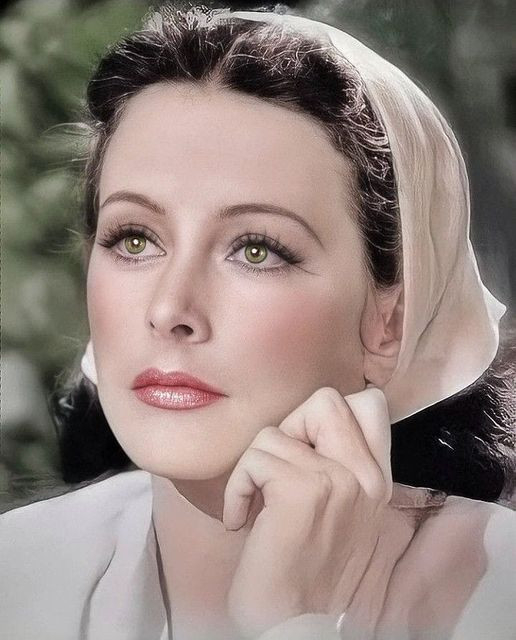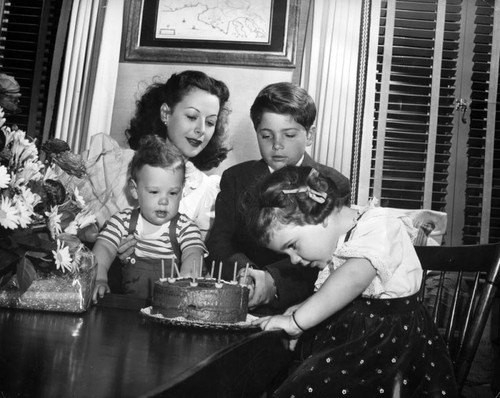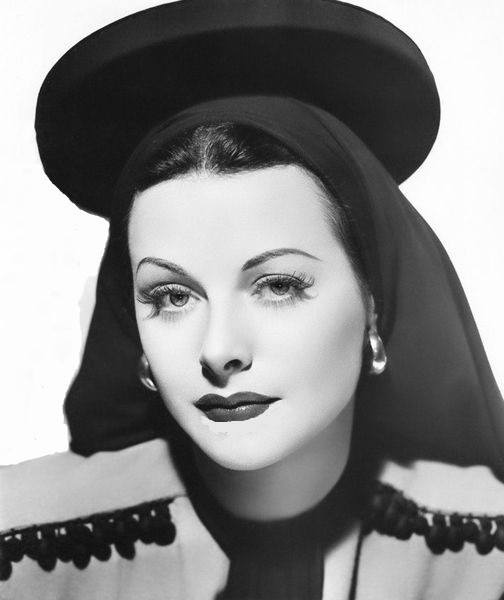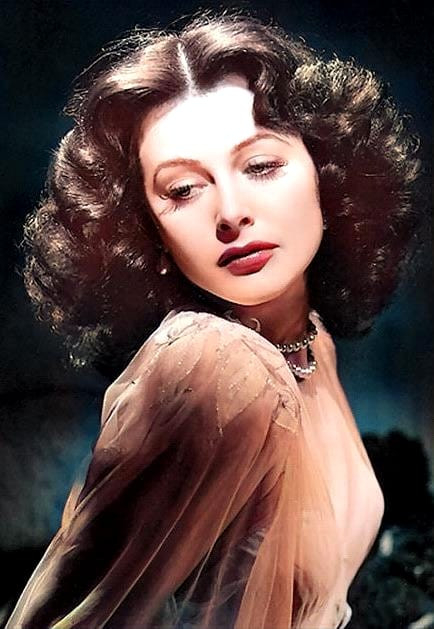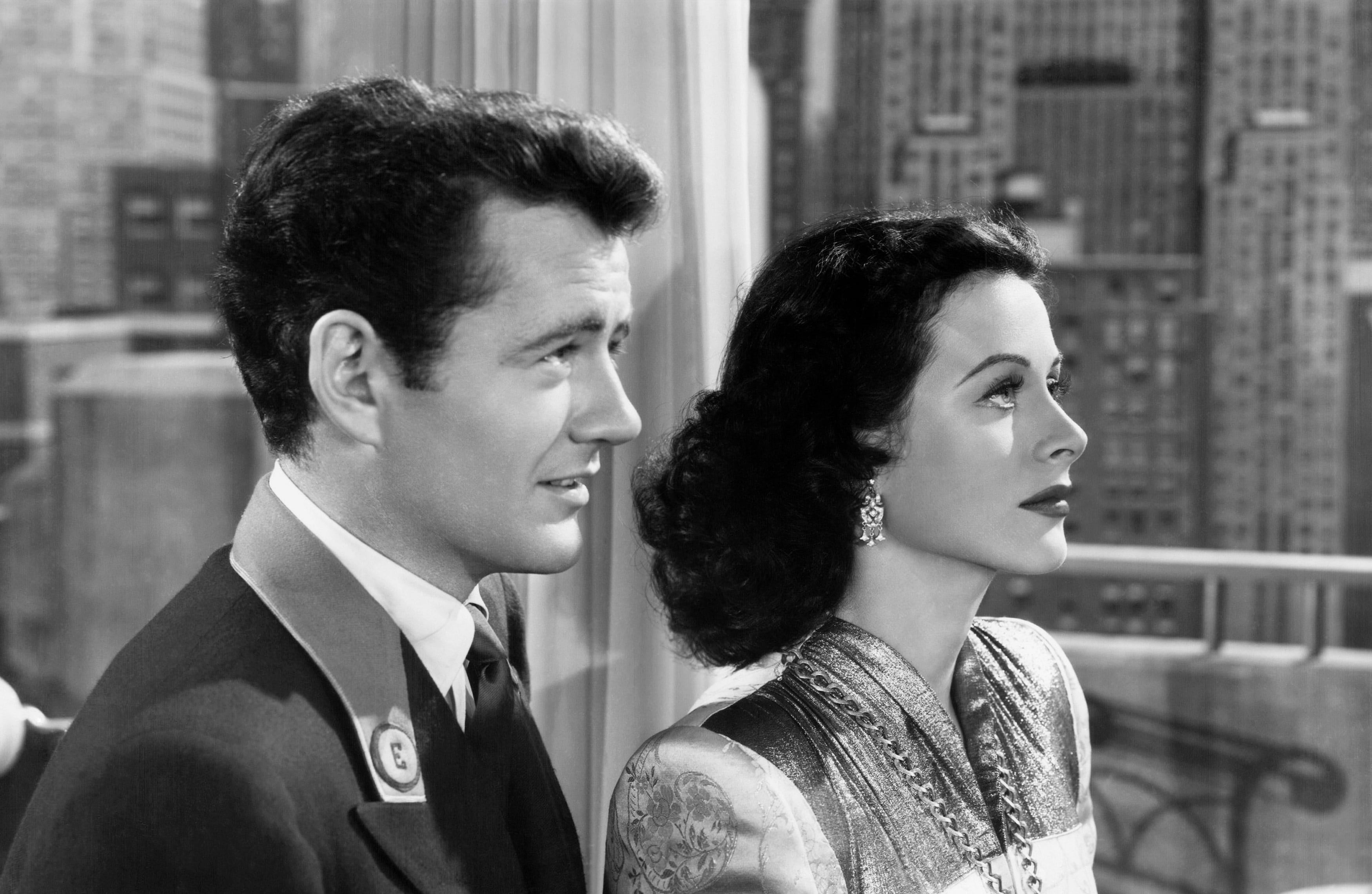Hedy Lamarr, the raven-haired Viennese beauty who became one of the reigning temptresses in Hollywood films in the 1930's and 40's, especially as Delilah vamping Victor Mature's Samson, was found dead in her home in Orlando, Fla., yesterday. She was 86.
Miss Lamarr was forever identified with ''Ecstasy,'' a 1933 Czech film in which she appeared nude in a swimming scene and in a lovemaking sequence that was torrid for its time. The film was banned in many places in the United States for a number of years. But even though most Americans never saw it, ''Ecstasy'' excited their interest in the actress and shaped her career.
But as David Thomson, the film historian, said of her work in the United States: ''It became her lot to be cast as exotic, sultry women -- and she did her best; but conscientiousness is not quite what we expect in our femme fatales. Too often, she had a worried look.''
Miss Lamarr was born Hedwig Eva Marie Kiesler in Vienna, the daughter of a well-to-do banker and a concert pianist. She studied acting with Max Reinhardt in Vienna in 1931. He watched her read her lines one day and declared that she was either ''the most beautiful girl in the world'' or ''the most beautiful girl in Europe.'' (Press reports at the time carried both versions.)
She appeared in a few films before ''Ecstasy,'' a mostly silent film that was well received in Europe, where it was released as ''Symphonie der Liebe.'' Pope Pius XI denounced it, but Mussolini issued a permit so that it could be shown at the Venice Film Festival. It won no awards there but attracted attentive audiences, most of them men.
By the time ''Ecstasy'' had begun to make the rounds in Europe, Miss Kiesler was married to the first of her six husbands, Fritz Mandl, a Viennese munitions maker who was then in the process of making a tidy fortune by selling his wares to the Nazis. Mr. Mandl was upset by the film and spent a great sum of money tracking down and purchasing prints of ''Ecstasy'' so that nobody would see it. He explained that it was not so much because his wife could be seen nude, but because of the look on her face during the sex scenes.
Mr. Mandl came to regret all the money he spent buying the film. He didn't get all the prints. Then the Nazis seized his factory (he didn't pay his taxes, they claimed), and Miss Kiesler left him (she thought he was dull) and made her way to London. There she got an acting job and was seen by Louis B. Mayer, who immediately offered her a contract to work for MGM, his Hollywood studio. Mr. Mayer changed her name to Lamarr after a silent film star named Barbara La Marr, whom he admired.
''Ecstasy'' arrived in the United States in 1934 and was promptly banned in New York. It was the subject of numerous court tests in the 1930's.
When the star of ''Ecstasy'' arrived in New York on the liner Normandie in 1937, she was mindful that ''Ecstasy'' had arrived before her and was determined to have audiences believe she was more than just a pretty face. She refused to display her knees for the photographers from the New York dailies who met the ship (her skirt reached her ankles), and she asked them not to refer to her as Hedy Kiesler anymore. ''Please call me Hedy Lamarr,'' she said.
In 1938 she made her first American film, ''Algiers,'' with Charles Boyer, with the result that undergraduates at Columbia voted her the girl with whom they would most like to be marooned on a desert island. She became popular; men fantasized about her, and women began to wear their hair as she did, parted down the middle.
But Miss Lamarr never achieved the stardom of some of her fellow emigrees -- Greta Garbo, Greer Garson or Marlene Dietrich -- all of whom won plaudits not just for their sex appeal but also for their acting. The reviews of Miss Lamarr's films all emphasized her beauty, but when the scripts actually gave her something to say, the critics were not as passionate.
''Now that she has been given an opportunity to act,'' wrote Bosley Crowther, reviewing ''Lady of the Tropics'' for The New York Times in 1939, ''it is necessary to report that she is essentially one of those museum pieces, like the Mona Lisa, who were more beautiful in repose.''
When she played a seductress enchanting British plantation owners in Africa in ''White Cargo'' in 1942, Miss Lamarr purred, ''I am Tondelayo.'' This became grist for comedians; Jack Benny made many jokes on the radio about an imaginary salesgirl named Tondelayo Schwartzkopf.
In another of her best-known roles, she gave Victor Mature the ultimate haircut in ''Samson and Delilah,'' Cecil B. DeMille's 1949 epic. DeMille, who never overlooked the box-office potential of sexy women in the Bible and the actresses who played them, had a clinging gown made for her out of feathers from prize peacocks he kept.
Among Miss Lamarr's other films were ''Comrade X'' (1940) with Clark Gable, for King Vidor; ''Boom Town'' (also 1940), in which she seduced Gable. She also appeared as a showgirl with Judy Garland and Lana Turner in ''Ziegfeld Girl'' (1941), and with Spencer Tracy and John Garfield in ''Tortilla Flat'' (1942). She was considered difficult to please and was said to have turned down memorable parts that went to Gene Tierney (''Laura'') and Ingrid Bergman (''Casablanca'' and ''Gaslight.'') After her appearance in ''Samson and Delilah'' she went on to display her perfect profile in such films as ''Copper Canyon'' (1950), ''A Lady Without Passport'' (1950), the comedy ''My Favorite Spy'' (1951) and ''The Story of Mankind'' (1957) as her career faded . I saw her many times in "The Conspirators" with Paul Henreid.
Her private life was messy and sad.
In early 1939, she met Gene Markey, a writer and producer in Hollywood, and they eloped to Mexico. She divorced Mr. Markey the following year, complaining to a judge that they had been married for 14 months and that in all that time, he had spent only four evenings alone with her. The judge granted the divorce, but suggested that if she ever contemplated a future marriage, she should spend more than a month getting to know her man.
After her divorce from Mr. Markey, Miss Lamarr went to a Hollywood dinner party at the home of Janet Gaynor and there met George Antheil, the composer. Miss Lamarr and Antheil got to talking about the war and how tough it was going to be to stop the Nazis. As the story goes, Miss Lamarr recalled hearing some conversations that had occurred between her first husband, Mr. Mandl, and the Nazis, who seemed to place great value on creating some sort of device that would permit the radio control of airborne torpedoes and reduce the danger of jamming. She and Antheil got to discussing all this. The idea, they decided, was to defeat jamming efforts by sending synchronized radio signals on various wavelengths to missiles, which could then be directed to hit their mark.
Antheil supplied the technical expertise for the concept and on Aug. 11, 1942, the two received a United States patent for the use of radio-controlled missiles that could be used against the Germans. There were some doubts that Miss Lamarr had the technical background to give much to the project, but Antheil always credited her. The government was not initially interested in their device, but a refined version of it was used by the American military in the 1960's -- after the patent had expired. They never made a dime. In 1996 they were honored for their work by a professional engineering society. ''It's about time,'' was Miss Lamarr's only comment.
In 1941 Miss Lamarr was briefly engaged to the actor George Montgomery. She continued to make movies and worked hard to sell millions of dollars in war bonds. She told an audience in Philadelphia that she was just ''a gold digger for Uncle Sam.'' In the spring of 1943 she married the British actor John Loder. She knew him six months before she married him. They were divorced three years later.
Miss Lamarr's other marriages -- to Teddy Stauffer, a former band leader who ran a nightclub in Acapulco, Mexico; Howard Lee, a Texas oilman; and Lewis W. Boles, a West Coast lawyer -- all ended in divorce.
She adopted a son, James, and had two children with Loder, a son, Anthony, and a daughter, Denise; they all survive her.
Early in her career, a certain litigiousness manifested itself and continued to dog her existence. In 1943 she sued Loew's and MGM because they failed to pay her a contractual $2,000 a week. They said they were unable to pay her what they owed because President Franklin Delano Roosevelt had issued a wartime executive order limiting all salaries to $25,000 a year. The case was settled out of court.
Over the years, she was involved in several other lawsuits that did not work out so well. Among them was one against a Los Angeles department store that had accused her of shoplifting. (She was acquitted of the charge, and her own lawsuit against the store was dismissed.)
Best known of her lawsuits was one directed in the 1960's and 70's against the publisher and ghostwriter of ''Ecstasy and Me: My Life as a Woman,'' an autobiography that was intended to revive her notoriety as a sex goddess. She said the book was ''deliberately written as an obscene, shocking, scandalous, naughty, wanton, fleshy, sensual, lecherous, lustful and scarlet version'' of her life. Her suit failed.
In 1991, living sparingly in South Florida, she was again accused of shoplifting ($21 worth of personal-care items from a drug store) but not prosecuted. In recent years, Miss Lamarr lived quietly in a suburb of Orlando. Friends said she was legally blind and did not venture out on her own.
''What happened to me?,'' Miss Lamarr asked the syndicated columnist Sheilah Graham in 1966. ''I made $7 million and yet I was on relief and they gave me all of $48 a week.''
''I'm not so crazy about acting,'' she told Miss Graham. ''All that makeup and getting up so early. Maybe I'll go to Europe. Oh, they want me. I have many offers.''Hedy Lamarr died on January 19, 2000 at 85 years old. She was born on November 9, 1914.
ADVERTISEMENT
BY
Looking for more information?
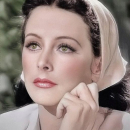
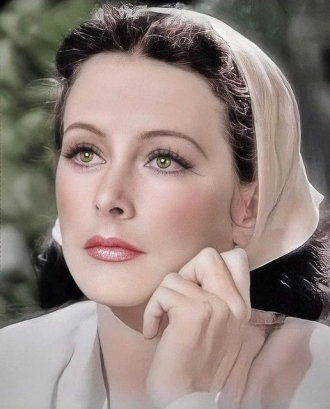
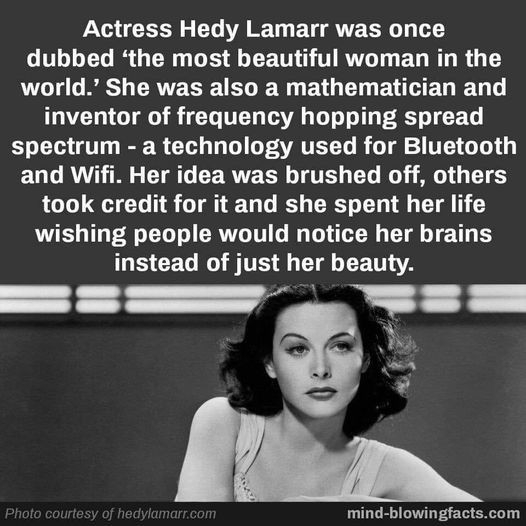
 Amanda S. Stevenson
Amanda S. Stevenson 